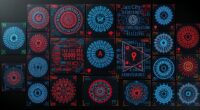If you want to boost your cybersecurity skills in 2025, I recommend exploring key books like *The Hacker Playbook 3*, *Kali Linux Penetration Testing Bible*, and *Hands-on Hacking*. These guide you through practical techniques, tools, and real-world scenarios tailored for both beginners and professionals. Focus on those that cover modern attack methods, frameworks, and cloud security. Keep exploring, and you’ll find essential insights to sharpen your penetration testing expertise.
Key Takeaways
- Prioritize books covering practical skills, tools, and frameworks like Kali Linux, Metasploit, and Nmap for hands-on cybersecurity mastery.
- Select titles that balance depth and accessibility, such as “The Hacker Playbook 3” and “Penetration Testing for Dummies.”
- Focus on resources that include real-world scenarios, lab exercises, and step-by-step guides for effective learning.
- Consider updated publications addressing current attack techniques, cloud security, and advanced network assessment methodologies.
- Choose comprehensive guides that align with certifications like CEH and OSCP to boost career prospects in 2025.
Penetration Testing: A Hands-On Introduction to Hacking

Are you looking for a practical guide that takes you beyond theory and into real-world hacking skills? “Penetration Testing: A Hands-On Introduction to Hacking” is ideal for beginners and those shifting into cybersecurity roles who want to develop hands-on abilities. This book emphasizes practical skills over abstract concepts, covering tools like Kali Linux, Metasploit, Nessus, and aircrack with step-by-step instructions. It guides you through setting up labs, understanding hacking techniques, and developing real-world expertise. Though lab setup can be time-consuming and challenging, resourcefulness is key. Overall, it’s an invaluable resource for anyone serious about building practical pentesting skills.
Best For: Beginners and cybersecurity professionals seeking a practical, hands-on introduction to penetration testing and hacking techniques.
Pros:
- Emphasizes practical skills with step-by-step instructions and real-world applications.
- Covers a comprehensive range of tools like Kali Linux, Metasploit, Nessus, and aircrack.
- Suitable for those aiming to transition into security roles and preparing for certifications like CEH and OSCP.
Cons:
- Setting up the lab environment can be time-consuming and resource-intensive.
- Some tools and resources may be outdated or require additional effort to locate and configure.
- Mobile device penetration chapters may be less engaging due to setup complexities and additional framework requirements.
Hacking and Security Book: Ethical Hacking, Penetration Testing & Cybersecurity

If you’re serious about mastering cybersecurity, “Hacking and Security: Ethical Hacking, Penetration Testing, and Cybersecurity” stands out as an essential resource. This extensive guide, published in 2023, covers nearly 1200 pages of current, in-depth content, including practical examples, diagrams, and code snippets. It’s perfect for both beginners and experienced professionals, offering insights into attack methods, security frameworks, and tools like Kali Linux, Nmap, and Wireshark. The book’s structured like a course, making complex topics accessible. Its detailed approach helps deepen understanding of cybersecurity concepts, making it a must-have reference for anyone looking to enhance their skills in this rapidly evolving field.
Best For: cybersecurity students, security professionals, and IT practitioners seeking a comprehensive and practical guide to ethical hacking, penetration testing, and cybersecurity.
Pros:
- Extensive coverage with nearly 1200 pages of current, in-depth content and practical examples
- Clear explanations of complex concepts with diagrams, code snippets, and real-world scenarios
- Suitable for both beginners and experienced professionals, structured like a comprehensive course
Cons:
- The large size may require targeted reading or quick referencing rather than reading cover-to-cover
- Some topics, such as Linux installation, could benefit from more detailed instructions
- Physical book might be less convenient for on-the-go access compared to digital formats
Hands-on Hacking: Next-Gen Penetration Testing & Purple Teaming
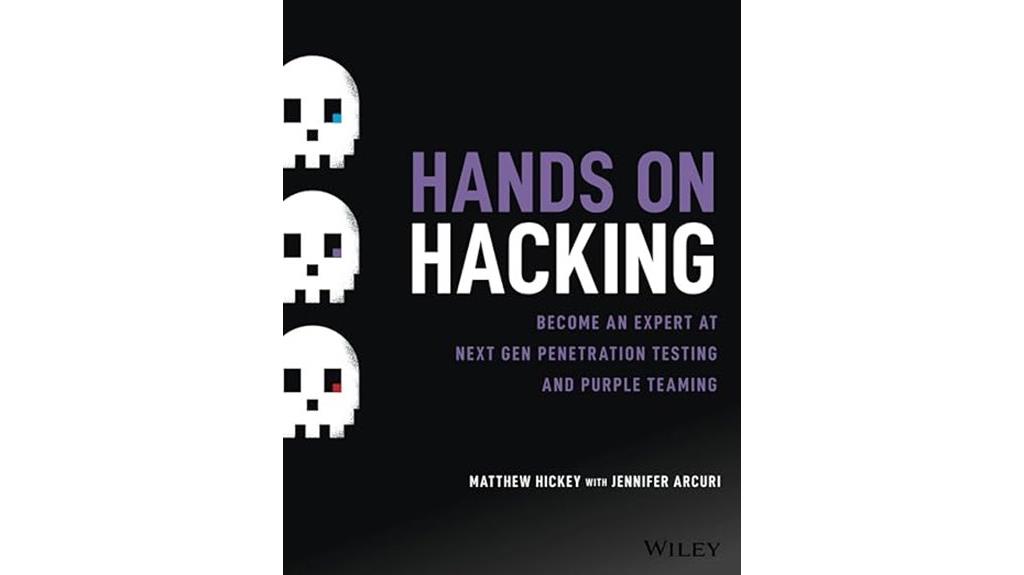
Hands-on Hacking: Next-Gen Penetration Testing & Purple Teaming is an excellent choice for beginners seeking practical, real-world experience in cybersecurity. This book offers step-by-step instructions, virtual labs, and challenges that help you develop essential skills like vulnerability assessment, reconnaissance, and exploitation. Its bootcamp-style approach introduces tools, techniques, and the hacker mindset, making complex concepts accessible. While it covers basic ideas, it provides a solid foundation for understanding attacks and defenses, especially in purple teaming. I recommend it for newcomers enthusiastic to build hands-on skills, deepen their understanding, and start their cybersecurity journey confidently.
Best For: beginners and newcomers eager to gain practical skills in cybersecurity, penetration testing, and purple teaming through hands-on exercises and real-world scenarios.
Pros:
- Provides clear, step-by-step instructions suitable for beginners
- Emphasizes practical experience with virtual labs and challenges
- Focuses on foundational skills and hacker mindset development
Cons:
- Covers basic concepts without delving into advanced topics
- Some included tools may not work as advertised, causing potential frustration
- May be too introductory for experienced cybersecurity professionals
The Hacker Playbook 3: Practical Guide To Penetration Testing

The Hacker Playbook 3 is an ideal choice for security professionals enthusiastic to deepen their offensive skills with practical, real-world techniques. It provides step-by-step strategies, tools, and labs that simulate actual attacks, making it highly applicable for both beginners and experts. The book covers modern attack methods like living off the land, bypassing security measures, and exploiting web vulnerabilities such as NoSQL Injection and advanced XSS. Its clear organization into phases—reconnaissance, web app attacks, and more—helps readers easily reference techniques. With hands-on exercises, real-world examples, and accessible explanations, it’s an essential resource for sharpening offensive security skills.
Best For: security professionals and penetration testers seeking practical, hands-on techniques to enhance their offensive security skills across real-world scenarios.
Pros:
- Provides detailed, step-by-step guidance on modern attack techniques and tools.
- Includes labs, exercises, and real-world examples to facilitate active learning.
- Suitable for both beginners and experienced professionals, with accessible explanations.
Cons:
- Some sections could benefit from improved organization for easier navigation.
- May require prior basic knowledge of cybersecurity concepts for full comprehension.
- Limited coverage of defensive strategies, focusing primarily on offensive techniques.
Kali Linux Penetration Testing Bible

Are you looking for a complete guide that bridges the gap between beginners and seasoned security professionals? The Kali Linux Penetration Testing Bible by Gus Khawaja is exactly that. It offers practical, step-by-step instructions on using Kali Linux tools, with clear explanations and real-world scenarios. The book covers Linux basics, scripting, networking, and advanced penetration tactics, making it suitable for all skill levels. Its hands-on approach helps you build confidence and skills through exercises and examples. While some sections may rehash fundamentals, the book remains a valuable resource for anyone serious about mastering Kali Linux for ethical hacking and cybersecurity.
Best For: security enthusiasts, beginners, and experienced professionals seeking a comprehensive, practical guide to mastering Kali Linux tools and penetration testing techniques.
Pros:
- Clear, step-by-step instructions with real-world scenarios for hands-on learning.
- Covers a wide range of topics from Linux basics to advanced hacking techniques.
- Suitable for all skill levels, making it a versatile resource for beginners and professionals alike.
Cons:
- Some pages may be prone to physical damage, such as tearing or sticking.
- Contains sections that extensively cover fundamentals, which may be redundant for advanced users.
- The scope can be somewhat inconsistent, targeting both novices and seasoned security experts, potentially leading to mixed focus.
Metasploit: The Penetration Testers Guide
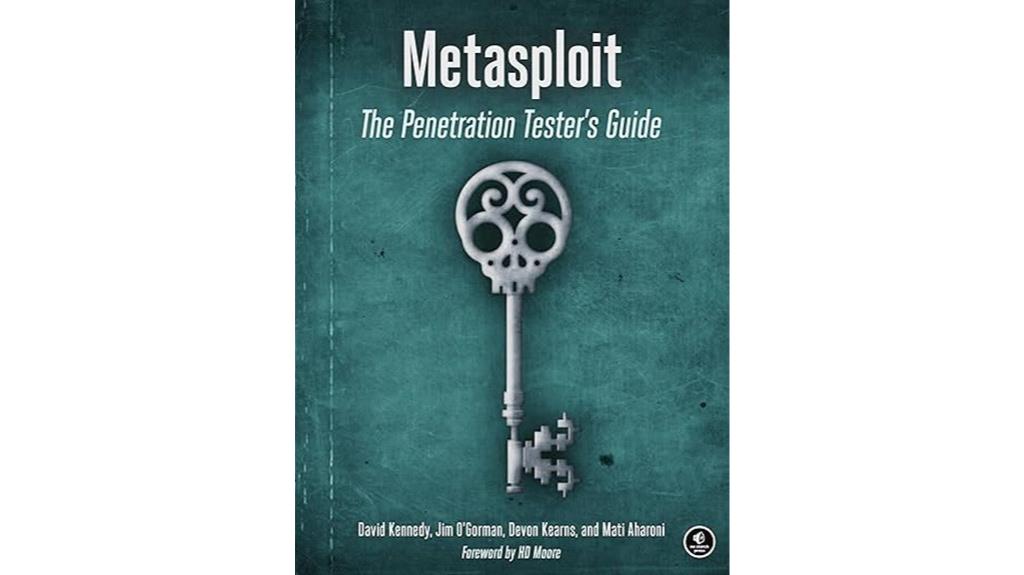
If you’re looking to master penetration testing with a practical tool, “Metasploit: The Penetration Testers Guide” is an ideal resource. It offers a thorough introduction to the Metasploit framework, covering everything from basic concepts to advanced exploitation techniques. The book explains how to configure targets, develop custom modules, and evade security defenses like IDS and antivirus software. I found its real-world examples and methodology guidance invaluable for understanding the entire testing process. Whether you’re a beginner or seeking to deepen your skills, this guide equips you with the tools, techniques, and mindset needed for effective, responsible penetration testing.
Best For: cybersecurity professionals, penetration testers, and students seeking a comprehensive guide to mastering the Metasploit framework for effective and responsible security testing.
Pros:
- Provides thorough coverage of both basic and advanced Metasploit techniques with real-world examples.
- Includes detailed explanations on developing custom modules and evading security defenses.
- Emphasizes a practical, methodology-driven approach aligned with industry standards like PTES.
Cons:
- Some content may become outdated due to frequent updates in Metasploit and related tools.
- Requires some programming knowledge, especially in Ruby, to fully leverage custom module development.
- As a foundational resource, it may not cover highly specialized or newer features in depth.
Penetration Testing For Dummies
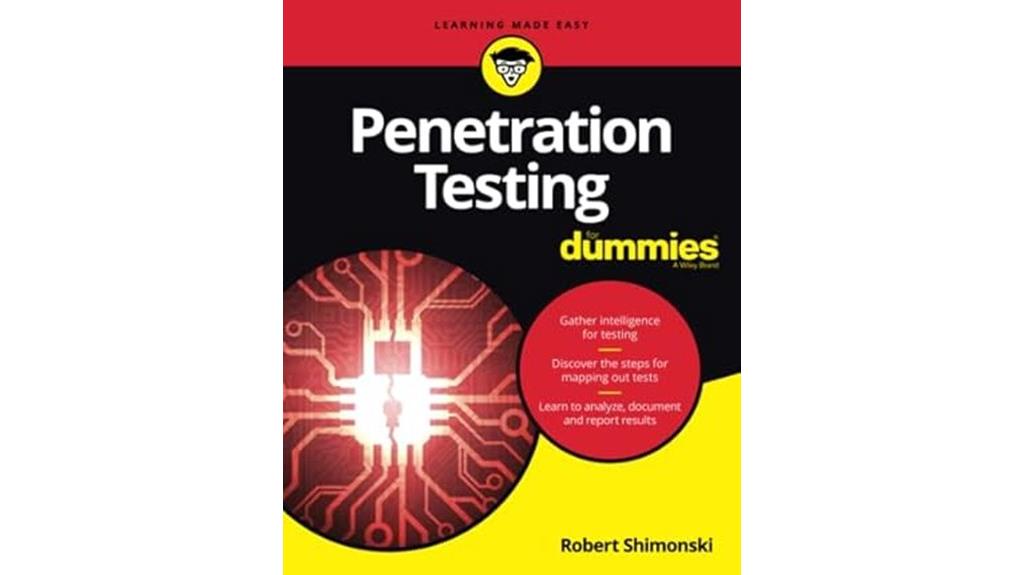
Looking to understand cybersecurity basics without getting overwhelmed? “Penetration Testing For Dummies” is an ideal starting point for beginners, non-IT professionals, and small business owners seeking a clear, straightforward introduction to ethical hacking. This book covers essential concepts, tools, and attack types like malware, exploits, and DoS attacks, helping you recognize threats. It also offers practical guidance on using tools such as Wireshark, Kali Linux, and Nmap through simple instructions and screen captures. Plus, it emphasizes ethical hacking and effective reporting, providing a solid foundation to identify vulnerabilities and improve your security posture confidently.
Best For: Beginners, non-IT professionals, and small business owners seeking a clear, accessible introduction to cybersecurity and ethical hacking.
Pros:
- Simplifies complex cybersecurity concepts for easy understanding
- Provides practical guidance with step-by-step instructions and screen captures
- Emphasizes ethical hacking and responsible security practices
Cons:
- Not a hands-on practice manual for in-depth technical skills
- May lack advanced or specialized cybersecurity techniques for experienced professionals
- Focuses primarily on foundational knowledge, limiting scope for advanced users
Metasploit, 2nd Edition

Metasploit, 2nd Edition stands out as an ideal resource for both beginners and experienced penetration testers seeking a practical, up-to-date guide to harnessing Metasploit’s full potential. The book’s clear layout covers essential tools, including reconnaissance, cloud pentesting, and wireless assessments, with real-world examples. It emphasizes developing custom modules in Ruby and other languages, inspiring hands-on experimentation. Personally, I gained confidence from its step-by-step module creation, which led to deploying Meterpreter on a Palo device. This book is a valuable, concise resource for expanding your skills and understanding of Metasploit’s capabilities in penetration testing today.
Best For: cybersecurity professionals, penetration testers, and hobby hackers looking to deepen their understanding of Metasploit and develop custom modules for practical penetration testing.
Pros:
- Well-organized content with clear instructions and real-world examples
- Focuses on practical module development in Ruby and other languages
- Suitable for both beginners and experienced users, boosting confidence and skills
Cons:
- Can be expensive relative to its content for some readers
- Lacks extensive programming tutorials for languages beyond Ruby, Perl, Python, C/C++
- Some users may find the depth of technical detail challenging without prior experience
Advanced Penetration Testing: Hacking the Worlds Most Secure Networks
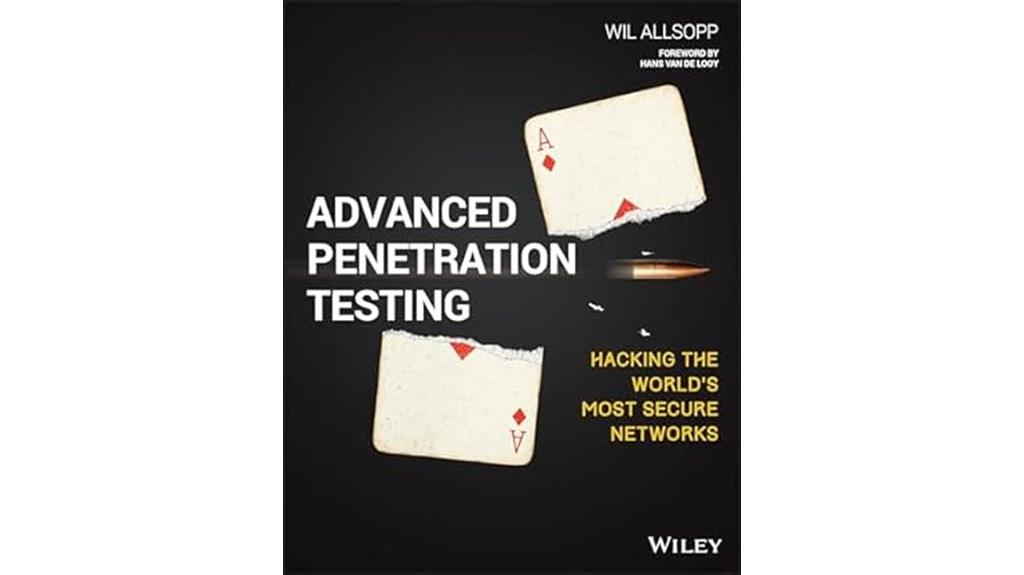
Advanced Penetration Testing: Hacking the World’s Most Secure Networks is an essential read for security professionals who want to deepen their understanding of real-world attack methods. Despite its brevity, it offers deep insights into how attackers breach highly secure networks like banks and pharma companies. Wil Allsopp emphasizes social engineering, reconnaissance, and clever tactics over malware, highlighting that strategic thinking is key. The book’s practical scenarios and engaging anecdotes make complex concepts accessible. It encourages hands-on practice and understanding attacker psychology, making it invaluable for offensive and defensive teams aiming to anticipate and thwart sophisticated threats. This book challenges traditional notions, focusing on attacker mindset and real-world tactics.
Best For: security professionals, penetration testers, and security managers seeking practical insights into advanced attack techniques and attacker psychology to strengthen their defenses.
Pros:
- Provides real-world attack scenarios that focus on social engineering and strategic thinking.
- Emphasizes understanding attacker mindset, making it highly relevant for both offensive and defensive roles.
- Clear explanations with engaging anecdotes and practical advice, encouraging hands-on practice.
Cons:
- Some readers may find the content somewhat formulaic, especially the heavy focus on social engineering.
- Certain technical areas lack in-depth exploration, which might challenge advanced practitioners seeking detailed technical guidance.
- The book’s brevity may limit comprehensive coverage of all attack vectors and exploits.
Ultimate Penetration Testing with Nmap: Master Cybersecurity Assessments for Network Security, Monitoring, and Scanning Using Nmap
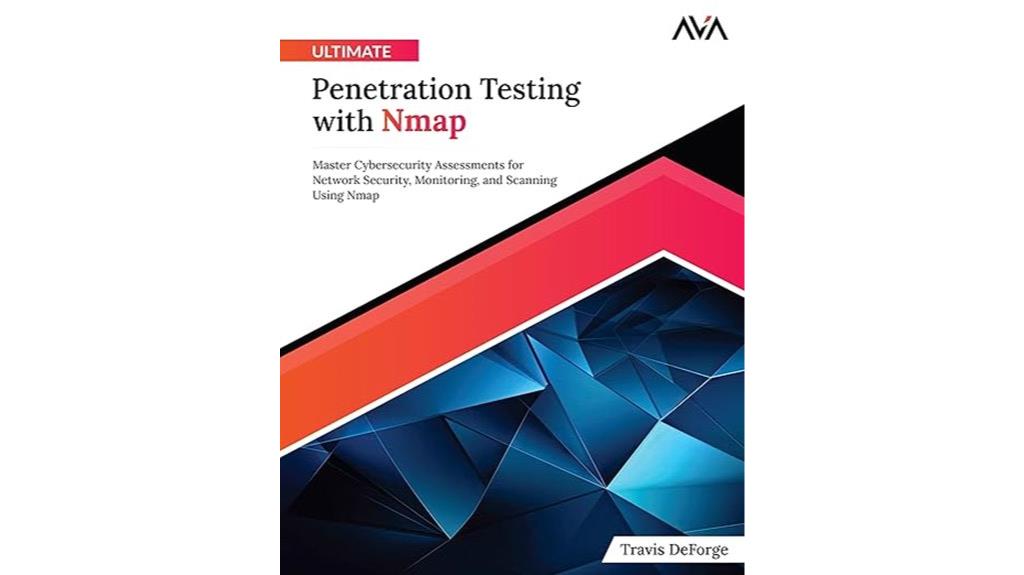
Are you a cybersecurity professional seeking to deepen your understanding of network reconnaissance and vulnerability assessment? “Ultimate Penetration Testing with Nmap” is the perfect resource for both beginners and experienced testers aiming to master advanced scanning techniques. This book emphasizes real-world applications, including sophisticated argument options, timing controls, and scripting, enabling you to uncover vulnerabilities and bypass security measures effectively. It offers practical case studies from seasoned experts, illustrating how Nmap can lead to network compromise or strengthen defenses. Whether you’re building a home lab or preparing for certifications, this book consolidates critical knowledge to elevate your penetration testing skills.
Best For: cybersecurity professionals, penetration testers, and students seeking to deepen their expertise in network reconnaissance, vulnerability assessment, and advanced Nmap techniques for real-world security assessments.
Pros:
- Comprehensive coverage of advanced scanning techniques and scripting interfaces.
- Incorporates real-world case studies providing practical insights from industry experts.
- Suitable for both beginners and experienced professionals, enhancing continuous learning.
Cons:
- May require prior basic knowledge of networking and cybersecurity concepts for full comprehension.
- Some advanced topics might be challenging without hands-on experience or supplementary resources.
- The detailed technical content could be dense for absolute newcomers expecting a beginner guide.
Pentesting Active Directory and Windows Infrastructure Guide
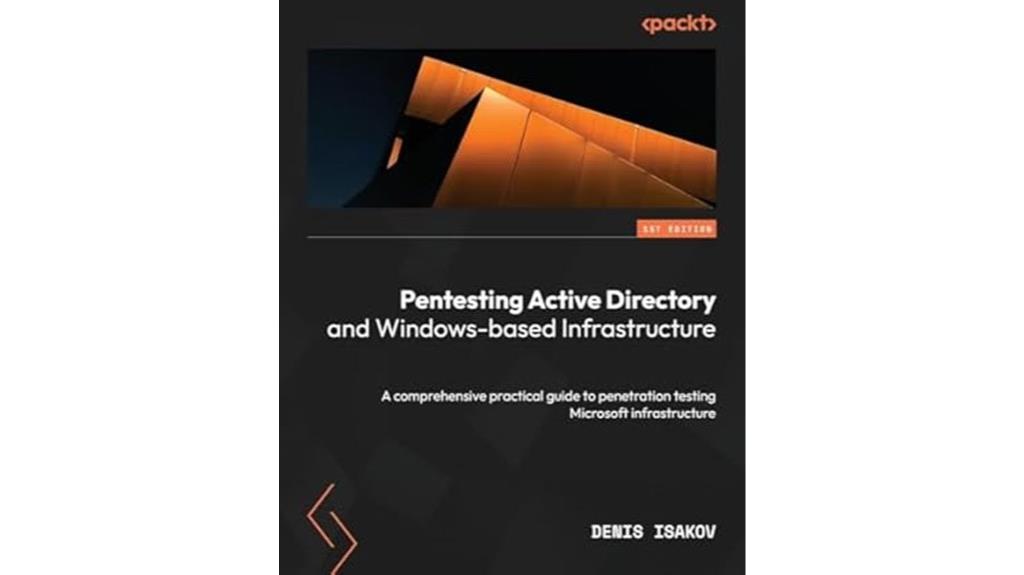
Looking to strengthen your skills in testing Windows environments? The “Pentesting Active Directory and Windows Infrastructure Guide” is a practical resource tailored for cybersecurity pros, red teamers, and defenders. It covers AD structure, attack vectors, and defense tactics, emphasizing real-world labs and security best practices. The book guides you through modern attack techniques like lateral movement, privilege escalation, and persistence, with step-by-step instructions and visual aids. While it focuses on Windows, it also offers valuable insights for internal testing. Though some attack vectors are omitted, it’s an excellent, structured introduction to AD pentesting, ideal for both beginners and seasoned professionals aiming to deepen their expertise.
Best For: cybersecurity professionals, red teamers, and network defenders seeking a practical, structured guide to testing and securing Windows Active Directory environments.
Pros:
- Emphasizes real-world labs and hands-on exercises for effective learning.
- Clear explanations and visual aids simplify complex AD attack and defense concepts.
- Covers modern attack techniques and best practices, making it relevant and up-to-date.
Cons:
- Omits some attack vectors such as NTLM relays and ZeroLogon vulnerabilities.
- Contains occasional logical errors and assumptions about prior tool knowledge.
- Limited coverage of Linux tools and advanced evasion techniques against modern defenses.
Penetration Testing Demystified: A Practical Guide

If you’re new to cybersecurity and want a straightforward, hands-on introduction to penetration testing, *Penetration Testing Demystified: A Practical Guide* is an excellent starting point. It offers a beginner-friendly overview, combining simple explanations with practical exercises and real-world examples. While it doesn’t explore deeply into advanced topics, it provides a solid foundation for understanding core concepts and tools used in penetration testing. The book’s step-by-step approach helps you actively develop relevant skills, making complex ideas accessible. Despite some repetitive style choices, it’s a valuable resource for anyone starting their cybersecurity journey and seeking an approachable, practical guide.
Best For: beginners in cybersecurity seeking a practical, easy-to-understand introduction to penetration testing with hands-on exercises.
Pros:
- Clear and simple explanations that make complex topics accessible
- Emphasis on practical exercises and real-world examples for active learning
- Suitable for learners at all levels, especially newcomers to cybersecurity
Cons:
- Offers only a superficial overview, lacking in-depth coverage of advanced topics
- Repetitive stylistic choices and metaphors can become tiresome
- Claims of making readers “experts” are misleading, as it provides foundational rather than expert-level knowledge
Cloud Penetration Testing Guide for AWS, Azure, and GCP

This cloud penetration testing guide is an excellent choice for beginners who want to build a solid foundation in cloud security. It combines theory and practical examples, covering AWS, Azure, GCP, containerization, and serverless architectures. I appreciate how accessible the language is, making complex concepts understandable without overwhelming newcomers. The book emphasizes real-world scenarios, tools, and methodologies, helping me learn how to identify vulnerabilities, conduct assessments, and exploit weaknesses. It also offers insights into defending against cloud attacks, making it a practical resource for both learning and applying cloud security skills effectively in modern environments.
Best For: beginners seeking a practical and accessible introduction to cloud security, including foundational concepts and real-world application.
Pros:
- Combines theory with practical examples, making complex topics easier to understand
- Covers major cloud platforms (AWS, Azure, GCP) alongside containerization and serverless architectures
- Emphasizes real-world scenarios, tools, and methodologies for effective learning and application
Cons:
- May be too basic for advanced practitioners seeking in-depth technical details
- Some sections, such as initial setup and common tools, are overly simplified
- Lacks depth in certain specialized areas, potentially requiring supplemental resources for expert-level skills
The Ultimate Kali Linux Book
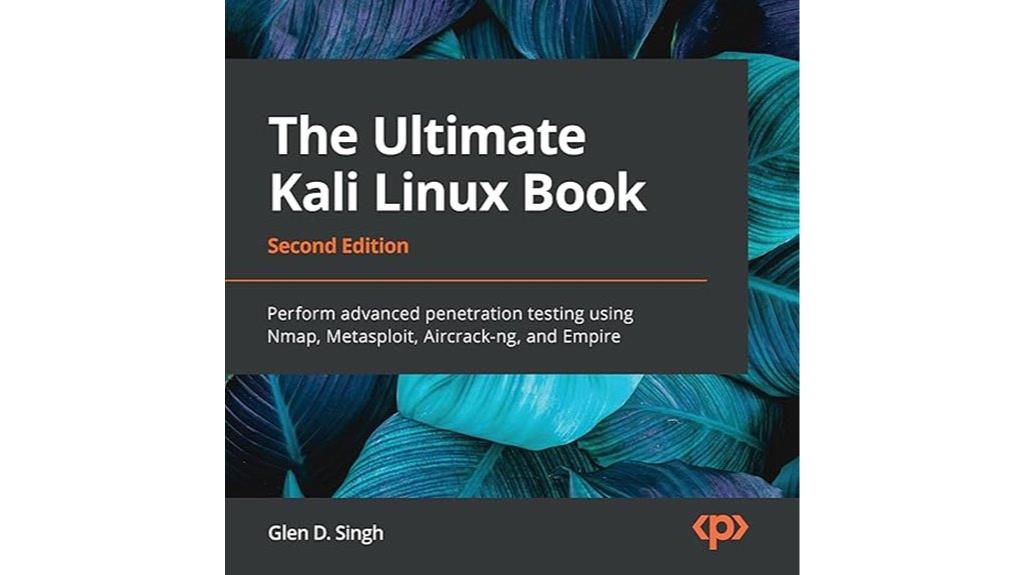
Are you seeking a thorough guide that transforms your penetration testing skills from beginner to expert? The Ultimate Kali Linux Book by Glen D. Singh is exactly what you need. It covers advanced tools like Nmap, Metasploit, Aircrack-ng, and Empire, offering detailed step-by-step guidance with visuals. Designed for those familiar with Linux and virtual labs, it emphasizes practical skills and real-world scenarios. The book serves as both a learning resource and a reference manual, making complex concepts accessible. If you’re serious about mastering Kali Linux for cybersecurity, this book provides a comprehensive, well-structured path to elevate your skills.
Best For: cybersecurity enthusiasts, penetration testers, and IT professionals seeking a comprehensive and practical guide to mastering Kali Linux and advanced penetration testing techniques.
Pros:
- Thorough coverage of advanced tools like Nmap, Metasploit, Aircrack-ng, and Empire with step-by-step visuals.
- Serves as both an educational resource and a practical reference manual for skill development.
- High-quality production with clear organization, making complex concepts accessible and engaging.
Cons:
- Some content may be redundant for readers with prior experience in penetration testing.
- Setup instructions are tailored for Windows environments, which might pose challenges for Linux-only users.
- Does not provide “magic formulas” for instant mastery; progress requires dedicated effort and practice.
The Art of Network Penetration Testing

The Art of Network Penetration Testing stands out as an essential resource for those who want a practical, step-by-step guide to internal network security assessments. I found its thorough coverage and real-world approach invaluable, breaking down the testing process into four clear phases. The book emphasizes factual techniques over flashy tools, with detailed examples on NMAP, Meterpreter, and report writing. Its flowcharts and exercises help clarify complex concepts, making it ideal for both beginners and seasoned professionals. I appreciate how it bridges theory and practice, offering actionable insights that boost confidence and skills for real engagements.
Best For: cybersecurity professionals, aspiring penetration testers, and technical teams seeking a practical, comprehensive guide to internal network security assessments.
Pros:
- Provides a clear, step-by-step methodology that is easy to follow and implement.
- Emphasizes real-world, factual techniques over dramatized hacking tools, enhancing practical applicability.
- Includes detailed flowcharts, examples, and exercises that clarify complex concepts like NMAP, Meterpreter, and report writing.
Cons:
- Environment setup guidance is mainly tailored for macOS, which may pose challenges for Windows users.
- Some readers may find the book could be longer, especially in the vulnerability exploitation phase.
- Focuses heavily on technical procedures, which might require supplementary resources for soft skills or organizational aspects.
Factors to Consider When Choosing a Penetration Testing Book

When selecting a penetration testing book, I always consider whether it matches my target skill level and learning style. I look for books that offer practical, hands-on content and stay current with the latest software tools. Ultimately, choosing the right book means balancing technical depth with relevance to my goals.
Target Audience Relevance
How do you choose a penetration testing book that truly matches your skill level and learning goals? First, guarantee the book’s target audience aligns with your experience—whether you’re a beginner, intermediate, or advanced. This helps maximize relevance and prevents frustration. Next, consider if it’s tailored for professionals, students, or trainers, so the content suits your current role. Check whether the topics—network, web, or cloud testing—match your focus area. Practical exercises and real-world scenarios are essential for applying knowledge effectively, so verify they’re included. Lastly, evaluate the approach and depth to ensure it complements your learning style and helps fill your knowledge gaps. Choosing the right audience match makes your learning efficient and engaging.
Technical Depth Level
Choosing a penetration testing book with the right technical depth is essential to match your current skills and learning objectives. If you’re a beginner, look for books that cover broad concepts, basic tools, and high-level overviews—these help build a solid foundation without overwhelming you. On the other hand, if you’re more experienced, you’ll need a book with detailed explanations of exploits, scripting, and vulnerabilities, often including real-world examples and code. The depth of content influences how much prior knowledge you should have; advanced books typically assume familiarity with Linux, scripting languages, and networking protocols. Picking a book that aligns with your skill level prevents frustration and ensures continuous progress, making your learning journey efficient and targeted.
Practical Hands-On Content
Selecting a penetration testing book with practical hands-on content guarantees you can directly utilize what you learn through real-world exercises, labs, and scenarios. I look for books that include step-by-step guides, tutorials, and challenge-based activities, which help reinforce my skills through active participation. The best books also offer downloadable resources like virtual machines, code snippets, and scripts, allowing me to experiment independently and deepen my understanding. Additionally, I prioritize books that cover setup instructions for lab environments, enabling me to simulate attacks and defenses safely. It’s essential that the practical content aligns with current industry tools and techniques, ensuring I acquire relevant skills that are immediately applicable to real cybersecurity challenges. Practical hands-on material makes learning much more effective and engaging.
Up-to-Date Software Coverage
Staying current with software coverage in a penetration testing book is essential because the cybersecurity landscape evolves rapidly. I look for books that cover the latest versions of key tools like Kali Linux, Metasploit, and Nmap, ensuring the techniques reflect current technology. It’s also imperative that the content includes recent updates on vulnerabilities, exploits, and attack methods, so I stay ahead of emerging threats. Modern operating systems, cloud environments, and mobile platforms should be addressed, as these are common targets today. Additionally, I check for references to new security standards, best practices, and compliance updates from the last few years. Finally, I want coverage of emerging areas like container security, serverless architectures, and IoT vulnerabilities, so I’m prepared for future challenges.
Learning Style Compatibility
When evaluating a penetration testing book, it’s important to contemplate how its teaching approach aligns with your personal learning style. If you prefer step-by-step tutorials, look for books that guide you through exercises and labs. If diagrams help you understand complex concepts, choose resources rich in visual aids like flowcharts and screenshots. For those who learn through reading and reflection, opt for books with clear, straightforward language and minimal jargon. If you’re a hands-on learner, prioritize books offering practical exercises to reinforce skills through active experimentation. Also, consider your current knowledge level—beginner, intermediate, or advanced—to ensure the material isn’t too basic or too overwhelming. Matching the book’s style to your learning preferences makes your study more effective and engaging.
How do you know if a penetration testing book is trustworthy? Look at the author’s credentials—cybersecurity certifications, hands-on experience, and industry involvement all matter. Authors with backgrounds in both offensive and defensive security tend to offer well-rounded insights and practical techniques. Recognized experts often contribute research, speak at security conferences, or actively participate in cybersecurity communities, which adds to their credibility. Books written by practitioners with real-world red teaming or penetration testing experience are typically more accurate and current. Additionally, credible authors regularly update their material to reflect the latest tools, vulnerabilities, and standards, ensuring you’re learning the most relevant techniques. Trustworthy authors are your best bet for acquiring reliable, actionable knowledge to advance your skills.
Supplementary Resources Availability
Choosing a reputable author is important, but equally essential is ensuring the book offers valuable supplementary resources that enhance your learning. I look for books that provide links, QR codes, or references to online repositories with updated tools, scripts, and materials. Access to online labs, virtual environments, or downloadable practice scenarios is vital for hands-on experience. I also check if the author’s website or affiliated platforms regularly update resources to keep pace with cybersecurity advancements. Additionally, I value references to forums, communities, or guides that support ongoing education. Ensuring these resources are compatible with current operating systems and tools maximizes practical application. Well-curated supplementary resources make the book a continuous learning tool, not just a static reference.
Frequently Asked Questions
Which Books Are Best for Beginners in Penetration Testing?
You’re asking about the best books for beginners in penetration testing. I recommend starting with “The Web Application Hacker’s Handbook” for web security fundamentals and “Penetration Testing: A Hands-On Introduction to Hacking” to learn practical techniques. These books are clear, beginner-friendly, and provide hands-on exercises. They build a solid foundation, helping you understand core concepts before moving on to more advanced topics.
How Often Should I Update My Penetration Testing Library?
I believe you should update your penetration testing library regularly, ideally every six months. Cybersecurity threats evolve fast, and new tools or techniques come out constantly. Staying current guarantees you’re prepared for the latest vulnerabilities. I also recommend following industry news, blogs, and forums to stay informed. Regular updates help sharpen your skills and keep your toolkit effective against emerging cyber threats.
Are There Specific Books Focused on Cloud Security Testing?
Think of cloud security testing books as a treasure map guiding you through a vast digital landscape. Yes, there are specific books on this topic, like “Cloud Security and Privacy” by Ben Caudill or “AWS Security” by Chris McNab. These resources help you navigate the unique challenges of cloud environments, keeping your skills sharp. I recommend exploring these titles to deepen your understanding and stay ahead in cloud cybersecurity.
Can These Books Prepare Me for Industry Certifications?
You’re wondering if these books can prepare you for industry certifications. I believe they definitely can. Many of these books cover core concepts and practical skills that align with certification exams like OSCP, CEH, or CompTIA Pentest+. By studying these resources, you’ll build a solid foundation, gain hands-on experience, and boost your confidence to pass certification tests and excel in real-world penetration testing scenarios.
Do Any Books Cover Automation Tools in Penetration Testing?
When it comes to automation tools in penetration testing, a few books really hit the mark. They explore tools like Metasploit, Nmap, and Burp Suite, showing you how to automate tasks for efficiency. These books are like a treasure map, guiding you through scripting and automation to streamline your testing process. I recommend looking for titles that focus on practical, hands-on automation to stay ahead of the curve.
Conclusion
As you plunge into these books, picture yourself wielding a flashlight in a dark room, revealing hidden vulnerabilities and illuminating paths to stronger defenses. Each page is a stepping stone, guiding you through shadows of complexity toward clarity and mastery. Embrace the journey, and soon you’ll navigate the intricate maze of cybersecurity with confidence, turning unseen threats into clear targets. Your skills will shine brighter, illuminating a safer digital world.

